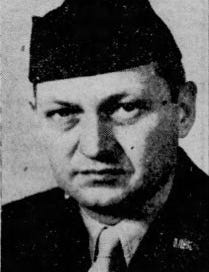Brothers reunite on the beach at Anzio
War correspondents of the 1940s came from a variety of journalistic backgrounds. Some had been foreign correspondents, but many more were writing about city hall or sports before finding themselves on the front lines of the biggest story of the century.
Price Day had done his share of nuts-and-bolts newspaper work before shipping overseas in December 1943 to cover the air war for the Baltimore Sun and Evening Sun, but he also had spent years writing fiction for a variety of magazines, from the Saturday Evening Post to Collier's. That experience, and the degree of free rein offered by the Sunpapers, as they were known, helped make Day one of the more enjoyable reads of the era.
His prose reads more like magazine work than typical just-the-facts newspaper fodder, with beautifully constructed scenes and set pieces adorning what in other scribes' hands might just be yet another daily update from the front.
Day initially covered the Eighth Air Force from England before moving on to follow the war in Italy, the invasion of Southern France, and Germany's ultimate surrender.
Among the scores of engrossing stories he filed from Europe, though, one stands out: a first-person account of his reunion with his younger brother on the beachhead at Anzio. The piece ran on the front page of the Sun on May 11, 1944, with this opening paragraph:
What we said first, I don't remember. It didn't matter. Anything would have done.
Nowhere in the few hundred words that follow does Day mention his brother by name, and the reason for the omission becomes clear momentarily.
Later I was to think of the hundreds of thousands of people in the States whose sons and brothers and husbands and sweethearts and fathers are in the combat troops -- people with a little core of fear always in their hearts and who sweat out the slow mails and read and reread short letters that say so little when you want to know so much.
I was a thousand times luckier than they, but perhaps from my first meeting with my younger brother in more than two years, some of them can know what their own meetings will be like.
Day's brother stands in for that anonymous soldier far from home throughout the piece. The writer describes how he looks, what he's wearing. Throws in a few older-brotherly jabs.
"Do you shave yet?" I said.
He grinned. "About once a month."
The paint on his helmet is worn off around the edges, showing steel. The roughness is worn from the paint, too. The sweatband is stained almost black. There is a small hole through the top and the liner.
The hole was made by an anti-personnel fragment, but he wasn't wearing the helmet at the time. He had dived into a dugout. The helmet was outside.
There are no profound exchanges of the type you would surely see in any Hollywood version of this story, from the 1940s to the present. It's simple, clean, straightforward -- and all the more moving for it.
The story concludes:
We looked at each other.
"Take care of yourself," I think I said.
"Don't take any chances," he said.
Price Day was 36 when he wrote the story. His brother, John, had turned 20 a few weeks earlier. Both would ultimately escape from Anzio and the rest of the war unscathed.
Price was the only representative of an individual newspaper present for Gen. Alfred Jodl's surrender in Rheims, France, on May 7, 1945. His masterful account of the end of the war in Europe ends like this:
Then, in what seemed no more time than is needed for the drawing of a breath, the Allied officers had arrived, the Germans had come, all were seated at the big ugly table, Jodl signed his name, once, twice, a third time, and a fourth time; then, carefully, neatly, he put down the pen.
He would go on to win the Pulitzer Prize for international reporting in 1948 before transitioning from reporter to editor four years later. He would serve as editor in chief of the Sunpapers for 15 years before retiring in 1975.
At the time of his death in 1978 at age 71, all four of Price Day's sons were working as journalists.
His brother John took a different tack but was no less successful. The younger Day became a professor of medieval history, earning a Guggenheim Fellowship in 1966 and specializing in the study of the medieval economy.
He lived and taught in Paris for years and died there in 2003 at age 78.




